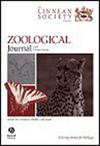The species problem in Artemia Leach, 1819 (Crustacea: Anostraca), a genus with sexual species and obligate parthenogenetic lineages
IF 3
2区 生物学
Q1 ZOOLOGY
引用次数: 0
Abstract
Parthenogenesis is an asexual reproduction mode characterized by the development of a female oocyte without fertilization. From an evolutionary perspective, parthenogenesis seems less successful than the predominant sexual mode, though there are groups in which both reproductive types exist, an example of which is the genus Artemia Leach, 1819. This salt-tolerant crustacean inhabiting hypersaline environments contains regionally endemic sexual species and obligate parthenogenetic groups with different ploidy levels, collectively referred to as Artemia parthenogenetica. Here, we discuss the difficulties of using a common species concept in Artemia Leach, 1819. While sexual species are widespread and fit the Biological Species Concept (BSC), which emphasizes reproductive isolation to maintain species genetic integrity or cohesiveness, it does not apply to uniparental organisms originating from sexual species with major meiotic changes. We show that different ploidy levels of parthenogenetic Artemia groups with uniform nuclear gene pools are maternally independent genetic entities (or cohesive), collectively and wrongly referred to as Artemia parthenogenetica. Thus, we conclude that ‘Artemia parthenogenetica’ is an invalid nominal specific name. Additionally, parthenogenetic Artemia groups cannot be considered a form of Artemia species (A. urmiana and/or A. sinica). In conclusion, we recommend using the term ‘parthenogenetic lineage(s)’ instead of ‘parthenogenetic population(s)’ to describe asexual Artemia group(s), because in modern population genetics and systematics, the term ‘population’ refers to interbreeding individuals with sexual reproduction. Furthermore, it clarifies that parthenogenetic lineages of Artemia are native to Mediterranean biodiversity.Artemia Leach,1819(甲壳纲:Anostraca)中的物种问题,一个有性种和强制性孤雌生殖系的属
孤雌生殖是一种无性繁殖模式,其特点是雌性卵母细胞发育而不受精。从进化的角度来看,孤雌生殖似乎不如主要的有性生殖模式成功,但也有一些群体同时存在这两种生殖类型,例如 Artemia Leach, 1819 属。这种栖息在高盐度环境中的耐盐甲壳类包含区域特有的有性物种和具有不同倍性水平的强制性孤雌生殖群体,统称为孤雌生殖的Artemia。在此,我们讨论了在 Artemia Leach, 1819 中使用共同物种概念的困难。虽然有性物种很普遍,而且符合生物物种概念(BSC),该概念强调通过生殖隔离来维持物种遗传的完整性或内聚性,但它不适用于源自有性物种的单亲生物,因为有性物种具有重大的减数分裂变化。我们的研究表明,具有统一核基因库的不同倍性水平的孤雌生殖Artemia群体是母系独立的遗传实体(或内聚性),统称为孤雌生殖Artemia是错误的。因此,我们得出结论,"孤雌生殖的芸苔属 "是一个无效的专名。此外,孤雌生殖的 Artemia 群体不能被视为 Artemia 物种(A. urmiana 和/或 A. sinica)的一种形式。总之,我们建议使用 "孤雌生殖系(s)"而不是 "孤雌生殖种群(s)"来描述无性生殖的蒿类群,因为在现代种群遗传学和系统学中,"种群 "一词指的是有性生殖的杂交个体。此外,它还澄清了地中海生物多样性中的孤雌生殖Artemia品系。
本文章由计算机程序翻译,如有差异,请以英文原文为准。
求助全文
约1分钟内获得全文
求助全文
来源期刊
CiteScore
6.50
自引率
10.70%
发文量
116
审稿时长
6-12 weeks
期刊介绍:
The Zoological Journal of the Linnean Society publishes papers on systematic and evolutionary zoology and comparative, functional and other studies where relevant to these areas. Studies of extinct as well as living animals are included. Reviews are also published; these may be invited by the Editorial Board, but uninvited reviews may also be considered. The Zoological Journal also has a wide circulation amongst zoologists and although narrowly specialized papers are not excluded, potential authors should bear that readership in mind.

 求助内容:
求助内容: 应助结果提醒方式:
应助结果提醒方式:


